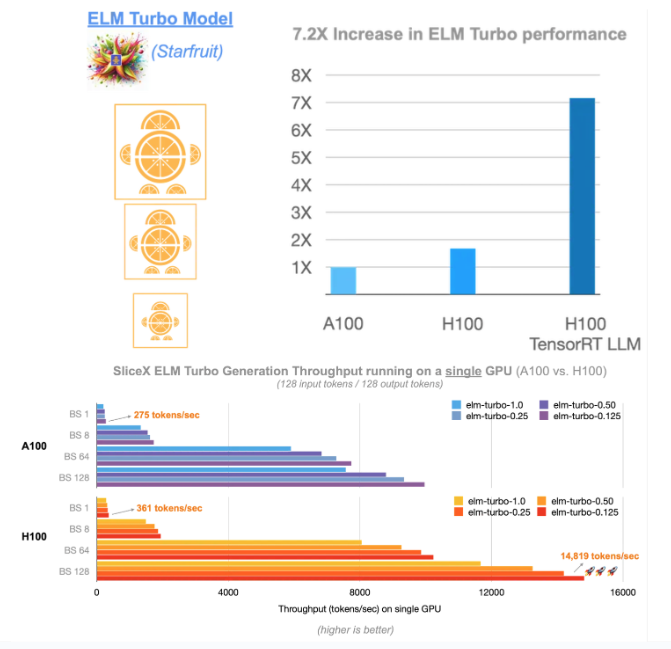Architecture | Results | Examples | Documentation
- [2024/07/30] Introducing🍊 @SliceXAI ELM Turbo 🤖 train ELM once ⚡ #TensorRT #LLM optimize ☁️ deploy anywhere ➡️ link

-
[2024/07/23] 👀 @AIatMeta Llama 3.1 405B trained on 16K NVIDIA H100s - inference is #TensorRT #LLM optimized ⚡ 🦙 400 tok/s - per node 🦙 37 tok/s - per user 🦙 1 node inference ➡️ link
-
[2024/07/09] Checklist to maximize multi-language performance of @meta #Llama3 with #TensorRT #LLM inference: ✅ MultiLingual ✅ NIM ✅ LoRA tuned adaptors➡️ Tech blog
-
[2024/07/02] Let the @MistralAI MoE tokens fly 📈 🚀 #Mixtral 8x7B with NVIDIA #TensorRT #LLM on #H100. ➡️ Tech blog
-
[2024/06/24] Enhanced with NVIDIA #TensorRT #LLM, @upstage.ai’s solar-10.7B-instruct is ready to power your developer projects through our API catalog 🏎️. ✨➡️ link
-
[2024/06/18] CYMI: 🤩 Stable Diffusion 3 dropped last week 🎊 🏎️ Speed up your SD3 with #TensorRT INT8 Quantization➡️ link
-
[2024/06/18] 🧰Deploying ComfyUI with TensorRT? Here’s your setup guide ➡️ link
-
[2024/06/11] ✨#TensorRT Weight-Stripped Engines ✨ Technical Deep Dive for serious coders ✅+99% compression ✅1 set of weights → ** GPUs ✅0 performance loss ✅** models…LLM, CNN, etc.➡️ link
-
[2024/06/04] ✨ #TensorRT and GeForce #RTX unlock ComfyUI SD superhero powers 🦸⚡ 🎥 Demo: ➡️ link 📗 DIY notebook: ➡️ link
-
[2024/05/28] ✨#TensorRT weight stripping for ResNet-50 ✨ ✅+99% compression ✅1 set of weights → ** GPUs\ ✅0 performance loss ✅** models…LLM, CNN, etc 👀 📚 DIY ➡️ link
-
[2024/05/21] ✨@modal_labs has the codes for serverless @AIatMeta Llama 3 on #TensorRT #LLM ✨👀 📚 Marvelous Modal Manual: Serverless TensorRT-LLM (LLaMA 3 8B) | Modal Docs ➡️ link
-
[2024/05/08] NVIDIA TensorRT Model Optimizer -- the newest member of the #TensorRT ecosystem is a library of post-training and training-in-the-loop model optimization techniques ✅quantization ✅sparsity ✅QAT ➡️ blog
-
[2024/05/07] 🦙🦙🦙 24,000 tokens per second 🛫Meta Llama 3 takes off with #TensorRT #LLM 📚➡️ link
Previous News
- [2024/02/06] 🚀 Speed up inference with SOTA quantization techniques in TRT-LLM
- [2024/01/30] New XQA-kernel provides 2.4x more Llama-70B throughput within the same latency budget
- [2023/12/04] Falcon-180B on a single H200 GPU with INT4 AWQ, and 6.7x faster Llama-70B over A100
- [2023/11/27] SageMaker LMI now supports TensorRT-LLM - improves throughput by 60%, compared to previous version
- [2023/11/13] H200 achieves nearly 12,000 tok/sec on Llama2-13B
- [2023/10/22] 🚀 RAG on Windows using TensorRT-LLM and LlamaIndex 🦙
- [2023/10/19] Getting Started Guide - Optimizing Inference on Large Language Models with NVIDIA TensorRT-LLM, Now Publicly Available
- [2023/10/17] Large Language Models up to 4x Faster on RTX With TensorRT-LLM for Windows
TensorRT-LLM is an easy-to-use Python API to define Large Language Models (LLMs) and build TensorRT engines that contain state-of-the-art optimizations to perform inference efficiently on NVIDIA GPUs. TensorRT-LLM contains components to create Python and C++ runtimes that execute those TensorRT engines. It also includes a backend for integration with the NVIDIA Triton Inference Server; a production-quality system to serve LLMs. Models built with TensorRT-LLM can be executed on a wide range of configurations going from a single GPU to multiple nodes with multiple GPUs (using Tensor Parallelism and/or Pipeline Parallelism).
The TensorRT-LLM Python API architecture looks similar to the
PyTorch API. It provides a
functional module containing functions like
einsum, softmax, matmul or view. The layers
module bundles useful building blocks to assemble LLMs; like an Attention
block, a MLP or the entire Transformer layer. Model-specific components,
like GPTAttention or BertAttention, can be found in the
models module.
TensorRT-LLM comes with several popular models pre-defined. They can easily be modified and extended to fit custom needs. Refer to the Support Matrix for a list of supported models.
To maximize performance and reduce memory footprint, TensorRT-LLM allows the
models to be executed using different quantization modes (refer to
support matrix). TensorRT-LLM supports
INT4 or INT8 weights (and FP16 activations; a.k.a. INT4/INT8 weight-only) as
well as a complete implementation of the
SmoothQuant technique.
To get started with TensorRT-LLM, visit our documentation:
- Quick Start Guide
- Release Notes
- Installation Guide for Linux
- Installation Guide for Windows
- Supported Hardware, Models, and other Software
- Model zoo (generated by TRT-LLM rel 0.9 a9356d4b7610330e89c1010f342a9ac644215c52)





